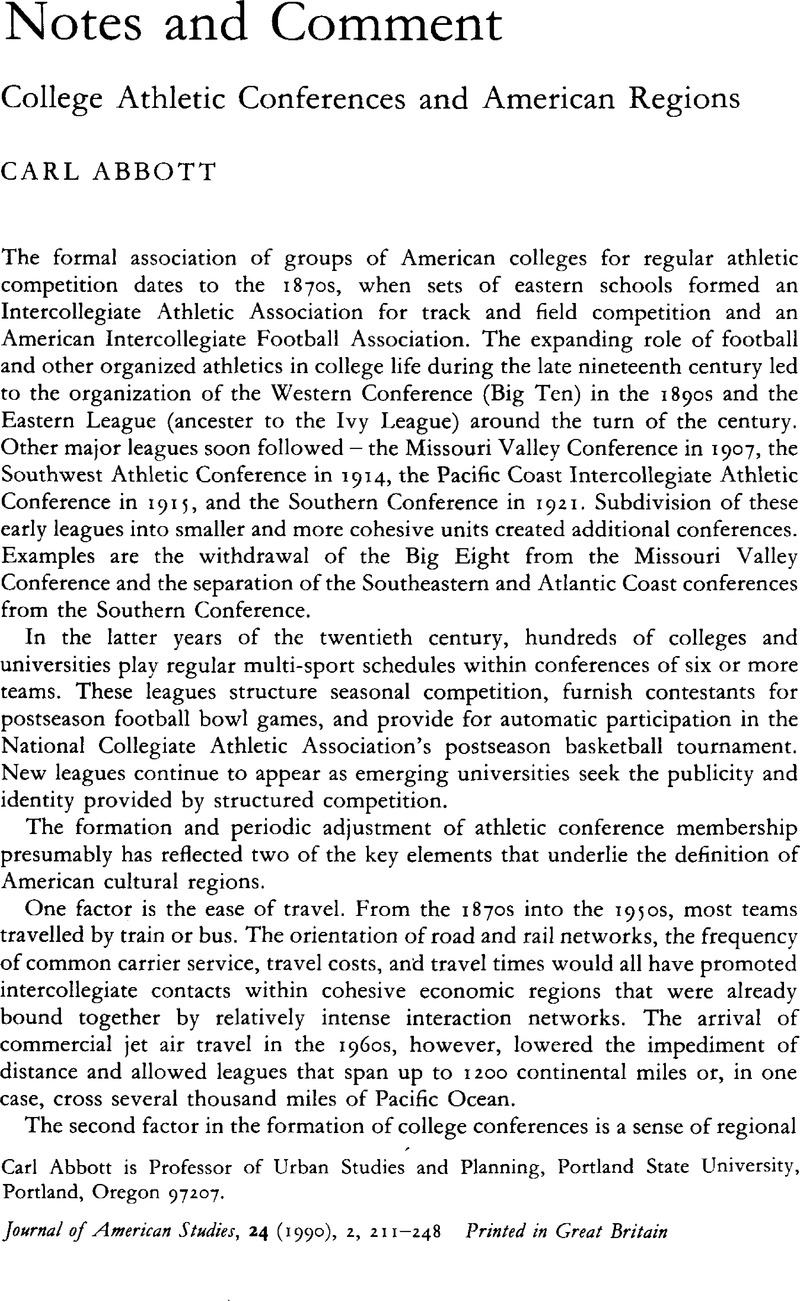Published online by Cambridge University Press: 16 January 2009

1 Hofstadter, Richard, “The Age of the College,” in Hofstadter, Richard and Metzger, Walter, The Development of Academic Freedom in the United States (New York: Columbia University Press, 1956), 211–14Google Scholar; Boorstin, Daniel, The Americans: The National Experience (New York: Random House, 1965), 153–60Google Scholar; Jencks, Christopher and Riesman, David, The Academic Revolution (Chicago: University of Chicago Press, 1977), 156–60.Google Scholar
2 Gossman, Charles S. et al. , Migration of College and University Students in the United States (Seattle: University of Washington Press, 1968).Google Scholar
3 Gottmann, Jean, Megalopolis: The Urbanized Northeastern Seaboard of the United States (New York: The Twentieth Century Fund, 1961)Google Scholar; Miller, Delbert, Leadership and Power in the Bos-Wash Megalopolis (New York: John Wiley, 1975).Google Scholar
4 Shortridge, James R., “The Emergence of “Middle West” as an American Regional Label,” Annals of the Association of American Geographers, 74 (06 1984), 209–220.CrossRefGoogle Scholar
5 Pomeroy, Earl, The Pacific Slope (New York: Alfred A. Knopf, 1965)Google Scholar; Abbott, Carl, “The Metropolitan Region: Western Cities in the New Urban Era,” in Nash, Gerald and Etulain, Richard (eds.), The Twentieth-Century West: Historical Interpretations (Albuquerque: University of New Mexico Press, 1989), 76–81.Google Scholar
6 Gastil, Raymond, The Cultural Regions of the United States (Seattle: University of Washington Press, 1975).Google Scholar
7 Atlantic Coast; Atlantic Ten; Big East; Big Eight; Big Sky; Big South; Big Ten; Central States; College Athletic; Colonial; Dixie; East Coast; ECAC-Metro Division; ECAC-North Atlantic Division; Gulf South; Gulf Star; Ivy; Metro; Metro Atlantic; Mid American; Mid Eastern; Mid Continent; Middle Atlantic States; Midwest Collegiate; Midwestern City; Missouri Valley; Ohio Valley; Pacific Ten; Rocky Mountain; Southeastern; Southern; Southland; Southwest; Southwestern; Sunbelt; Trans-America; Western; West Coast; Yankee.
8 Gastil's regions are grouped as Northeast (New England, Pennsylvania, New York Metropolitan); Middle West (Upper Midwest, Central Midwest); South (South); West (Interior Southwest, Pacific Southwest, Pacific Northwest, Mormon, Rocky Mountain).
9 Trans-regional athletic conferences according to census region boundaries are: Northeast-South (Atlantic Ten, Big East, East Coast, ECAC-Metro, Middle Atlantic); Middle West-South (College Athletic, Metro, Midwestern City, Missouri Valley, Ohio Valley); West-South-Middle West (Big Eight); West-South (Western). Use of Gastil's boundaries adds the Central States and Mid-Continent conferences to those spanning Middle West-South and eliminates the Western Conference as a trans-regional league.
10 Ullman, Edward, “Regional Development and the Geography of Concentration,” Papers and Proceedings of the Regional Science Association, 4, (1958), 179–98.CrossRefGoogle Scholar
11 Using census regions, the states participating only in regionally isolated leagues are as follows: Northeast (Maine, New Hampshire, Vermont); South (North Carolina, Georgia, Alabama, Arkansas, Louisiana); Middle West (Minnesota, Wisconsin); West (Washington, Oregon, Idaho, Montana, Nevada, Arizona). Use of Gastil's regions requires no changes for the Northeast and South; elimination of Wisconsin for the Middle West; and addition of Wyoming, Utah, New Mexico, California, and Hawaii for the West.
12 Gottman, , Megalopolis, 181–84Google Scholar; Bogue, Donald and Beale, Calvin, Economic Areas of the United States (Glencoe, III: Free Press, 1961).Google Scholar
13 Zelinsky, Wilbur, The Cultural Geography of the United States (Englewood Cliffs, NJ: Prentice-Hall, 1973)Google Scholar; Gutheim, Frederick, The Potomac (New York: Rinehart and Co., 1949).Google Scholar
14 Wade, Richard C., The Urban Frontier: The Rise of Western Cities, 1790–1830 (Cambridge, Mass.: Harvard University Press, 1959)Google Scholar; Power, Richard L., Planting Corn Belt Culture: The Impress of the Upland Southerner and Yankee in the Old Northwest (Indianapolis: Indiana Historical Society, 1953)Google Scholar; Clark, John G., The Grain Trade of the Old Northwest (Urbana: University of Illinois Press, 1966).Google Scholar
15 Zelinksy, Wilbur, “North America's Vernacular Regions,” Annals of the Association of American Geographers, 70 (03 1980), 1–16.Google Scholar
16 Belcher, Wyatt W., The Economic Rivalry between St. Louis and Chicago, 1850–1880 (New York: Columbia University Press, 1947)Google Scholar; Glaab, Charles, Kansas City and the Railroads (Madison: State Historical Society of Wisconsin, 1962).Google Scholar
17 The zone of greatest athletic interaction reflects such efforts to define a Mid-American cultural region as Elazar, Daniel, American Federalism: The View from the States (New York: Thomas Crowell, 1972), 103–26Google Scholar, or Jordan, Terry and Rowntree, Lester, The Human Mosaic (3rd ed.; New York: Harper and Row, 1986), 10.Google Scholar